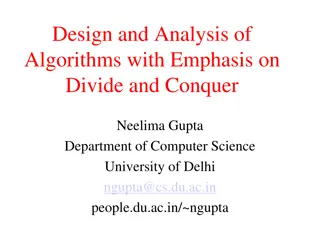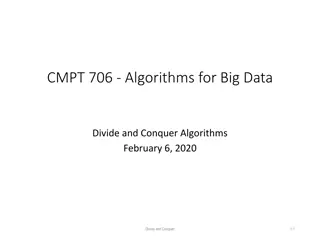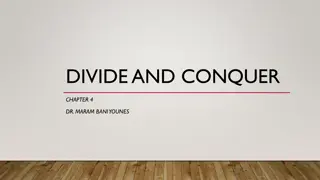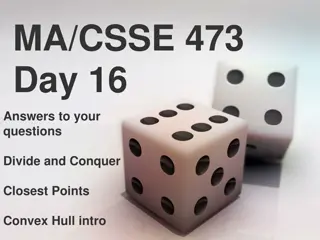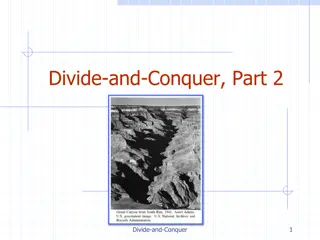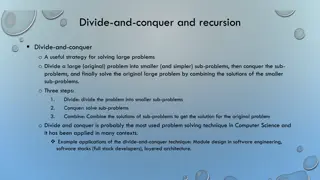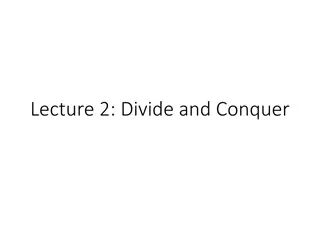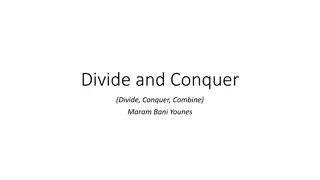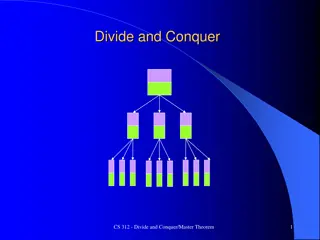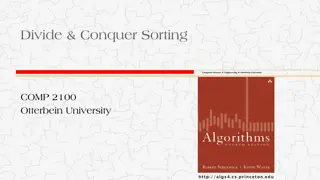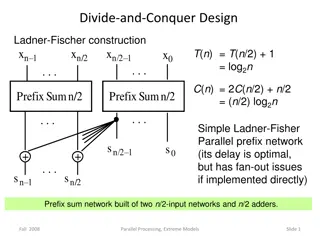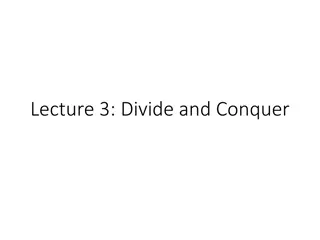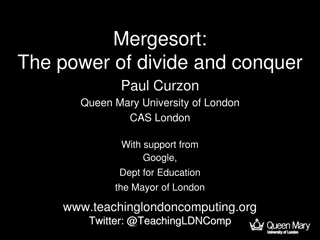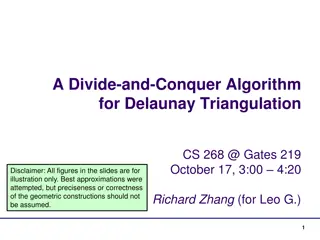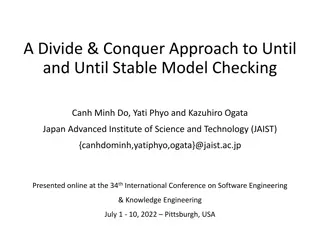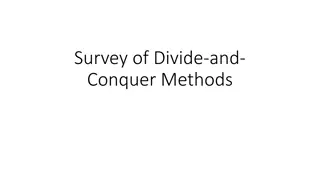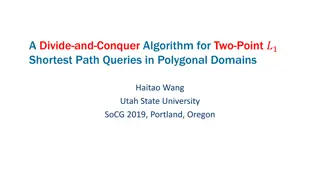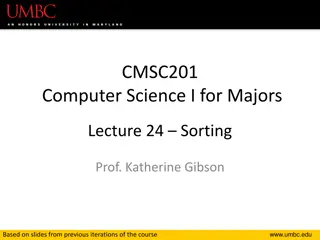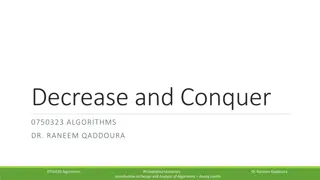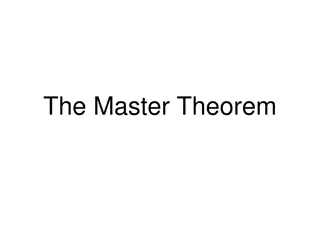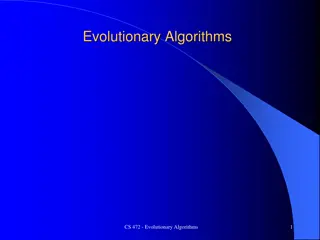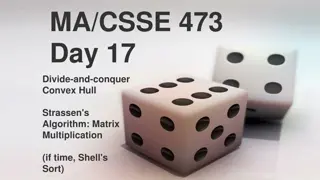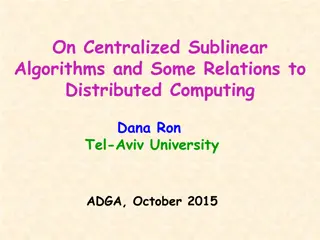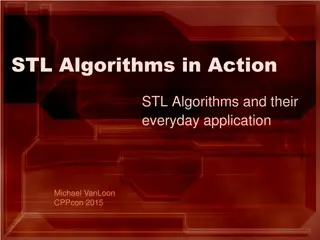Understanding Divide and Conquer Algorithms in Computer Science
In the recent lecture, we revisited topics such as the exam review, data compression, and mergesort. We also delved into a captivating puzzle set on the planet Og, exploring the logic behind truth-telling and lying natives. Furthermore, we discussed the transformation of recursive functions into non-recursive explicit forms and the analysis of their Big O complexity. The session emphasized the principles and application of divide and conquer algorithms, highlighting how problems are divided into smaller tasks, solved recursively, and then merged to derive the final solution.
Download Presentation

Please find below an Image/Link to download the presentation.
The content on the website is provided AS IS for your information and personal use only. It may not be sold, licensed, or shared on other websites without obtaining consent from the author. Download presentation by click this link. If you encounter any issues during the download, it is possible that the publisher has removed the file from their server.
E N D
Presentation Transcript
What did we talk about last time? Finished Exam 1 post mortem Data compression example Mergesort
On the planet Og, there are green people and red people Likewise, there are northerners and southerners Green northerners tell the truth Rednortherners lie Greensoutherners lie Redsoutherners tell the truth Consider the following statements by two natives named Orkand Bork: Ork: Bork is from the north Bork:Orkis from the south Ork:Bork is red Bork:Orkis green What are the colors and origins of Orkand Bork?
If we can, we want to turn the recursive version of T(n) into an explicit (non-recursive) Big Oh bound Before we do, note that we could similarly have written: ? 2 Also, we can't guarantee that n is even A more accurate statement would be ? 2 Usually, we ignore that issue and assume that n is a power of 2, evenly divisible forever ? ? 2? + ?(?) ? 2 ? ? ? + ? + ??
Each time, the recursion cuts the work in half while doubling the number of problems The total work at each level is thus always cn To go from nto 2, we have to cut the size in half (log2n) 1 times cn cn cn cn/2 cn/2 cn cn/4 cn/4 cn/4 cn/4
We know that there's cn work at each level and approximately log2 n levels If we think that the running time O(n log n), we can guess that T(n) cn log2n and substitute that in for T(n/2) ? ? 2? ? 2 = ?? (log2? 1) + ?? = ?? log2? ?? + ?? = ??log2? ? 2 + ?? ? 2 2? log2 + ??
Divide and conquer algorithms are ones in which we divide a problem into parts and recursively solve each part Then, we do some work to combine the solutions to each part into a final solution Divide and conquer algorithms are often simple However, their running time can be challenging to compute because recursion is involved
Defining a sequence recursively as with Mergesort is called a recurrence relation The initial conditions give the starting point Example: Initial conditions T(0) = 1 T(1) = 2 Recurrence relation T(k) = T(k-1) + kT(k-2) + 1, for all integers k 2 Find T(2), T(3), and T(4)
Consider the following recurrence relation: T(k) = 3 T(k-1) 1, for all integers k 1 Now consider this one: T(k+1) = 3 T(k) 1, for all integers k 0 Both recurrence relations have the same meaning
Even if the recurrence relations are equivalent, different initial conditions can cause a different sequence Example: T(k) = 3 T(k-1), for all integers k 2 T(1) = 2 S(k) = 3S(k-1), for all integers k 2 S(1) = 1 Find T(1) , T(2) , and T(3) Find S(1) , S(2) , and S(3)
Interest is compounded based on some period of time We can define the value recursively Let i is the annual percentage rate (APR) of interest Let m be the number of times per year the interest is compounded Thus, the total value of the investment at the kth period is P(k) = P(k-1) + P(k-1)(i/m), k 1 P(0) = initial principle
is confusing We don't naturally think recursively (but perhaps you can raise your children to think that way?) With an interest rate of i, a principle of P(0) , and m periods per year, the investment will yield P(0)(i/m + 1)k after k periods
We want to be able to turn recurrence relations into explicit formulas whenever possible Often, the simplest way is to find these formulas by iteration The technique of iteration relies on writing out many expansions of the recursive sequence and looking for patterns That's it
Find a pattern for the following recurrence relation: T(k) = T(k-1) + 2 T(0) = 1 Start at the first term Write the next below Do not combine like terms! Leave everything in expanded form until patterns emerge
In principle, we should use mathematical induction to prove that the explicit formula we guess actually holds The previous example (odd integers) shows a simple example of an arithmetic sequence These are recurrences of the form: T(k) = T(k-1) + d, for integers k 1 Note that these recurrences are always equivalent to T(n) = T(0) + dn, for all integers n 0
Find a pattern for the following recurrence relation: T(k) = rT(k-1), k 1 T(0) = a Again, start at the first term Write the next below Do not combine like terms! Leave everything in expanded form until patterns emerge
It appears that any geometric sequence with the following form T(k) = rT(k-1), k 1 is equivalent to T(n) = T(0)rn, for all integers n 0 This result applies directly to compound interest calculation
Intelligent pattern matching gets you a long way However, it is sometimes necessary to substitute in some known formula to simplify a series of terms Recall Geometric series: 1 + r + r2+ + rn = (rn+1 1)/(r 1) Arithmetic series: 1 + 2 + 3 + + n = n(n + 1)/2
In a complete graph, every node is connected to every other node If we want to make a complete graph with k nodes, we can take a complete graph with k 1 nodes, add a new node, and add k 1 edges (so that all the old nodes are connected to the new node) Recursively, this means that the number of edges in a complete graph is S(k) = S(k-1) + (k 1), k 2 S(1)= 0 (no edges in a graph with a single node) Use iteration to solve this recurrence relation
We can model the running time for binary search as a recurrence relation T(n) = T(n/2) + c, k 2 T(1)= c Use iteration to solve this recurrence relation Instead of plugging in values 1, 2, 3, , try powers of two: 1, 2, 4, 8,
We have seen that recurrence relations of the form ? ? 2? 2+ ??are bounded by O(n log n) What about ? ? ?? 2+ ??where q is bigger than 2 (more than two sub-problems)? There will still be log2n levels of recursion However, there will not be a consistent cn amount of work at each level ? ?
cn cn (3/2)cn cn/2 cn/2 cn/2 (9/4)cn cn/4 cn/4 cn/4 cn/4 cn/4 cn/4 cn/4 cn/4 cn/4
? 3 2 log2? 1 For q = 3, it's ? ? ?=0 In general, it's ?? log2? 1 log2? 1 ? ? ? 2 ? 2 ? ? ?? = ?? ?=0 ?=0 This is a geometric series, where ? =? 2 ?log2? 1 ? 1 ?log2? ? 1 ? ? ?? ??
?log2? 1 ? 1 ?log2? ? 1 ? ? ?? ?? Since r 1 is a constant, we can pull it out ? ? 1??log2? For ? > 1 and ? > 1, ?log ?= ?log ?, thus ?log2?= ?log2?= ?log2(?/2)= ?(log2?) 1 ? ? ? ?log2? ? ? ? ? ? 1? ?(log2?) 1 ? 1?log2? which is
We will still have log2n 1 levels However, we'll cut our work in half each time log2? 1 log2? 11 ? ? 2 1 2 ? ? ? + ?? ?? = ?? 2? ?=0 ?=0 Summing all the way to infinity, 1 +1 2+1 4+ = 2 Thus, ? ? 2?? which is ?(?)
Here's a non-recursive version in Java int counter = 0; for( int i = 1; i <= n; i *= 2 ) for( int j = 1; j <= i; j++ ) counter++; We've just shown that this is O(n), in spite of the two for loops
Assignment 3 is due on Friday Read section 5.3 Extra credit opportunities (0.5% each): Hristov teaching demo: Hristov research talk: 2/19 11:30-12:25 a.m. in Point 113 2/19 4:30-5:30 p.m. in Point 139


